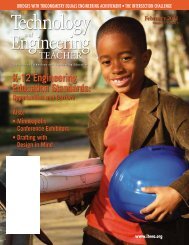Salt Lake City Conference Exhibitors Motor Mania - International ...
Salt Lake City Conference Exhibitors Motor Mania - International ...
Salt Lake City Conference Exhibitors Motor Mania - International ...
You also want an ePaper? Increase the reach of your titles
YUMPU automatically turns print PDFs into web optimized ePapers that Google loves.
A fire melts the ore so that the liquid iron separates from the<br />
rocky, non-iron materials. Coke is used to more efficiently<br />
heat the ore in the smelting process. To understand what<br />
coke is, consider charcoal. Common charcoal is the solid<br />
char leftover when wood is burned. Charcoal is useful<br />
because it ignites quickly and burns hot. Coke is like<br />
charcoal; it is what is left after partially burning coal. It has<br />
the same advantages of charcoal but has much more energy.<br />
Steel is most effectively refined when coke is used in blast<br />
furnaces. So, to fully smelt iron and produce steel with it,<br />
the manufacturer must fire coal to make coke, and then it<br />
must fire the coke to make steel. This is an energy-intensive<br />
process, and in the process, tons of greenhouse gases<br />
and toxic elements and compounds are released into the<br />
atmosphere annually.<br />
Recyclable Materials<br />
Consumers are aware of some recyclable materials but<br />
are less familiar with others. Consumers are familiar with<br />
the recycling of aluminum cans, paper, and some plastics<br />
because many communities encourage consumer recycling<br />
through local programs. It is not unusual for some forms<br />
of glass and steel cans to be accepted in consumer-level<br />
recycling programs. However, entire automobiles can<br />
be recycled for steel and aluminum and, in some cases,<br />
glass and plastics. Building demolitions also produce<br />
structural steel for recycling. Consumers are less aware<br />
of automobile recycling and structural steel recycling.<br />
Lead-acid automobile batteries are also recycled, as are the<br />
components of electronic hardware. The Institute of Scrap<br />
Recycling Industries (2007) reports the following statistics<br />
on recycling volumes in the United States annually.<br />
(Table 1.)<br />
Environmental Implications<br />
Land use is a big issue around the world. Landfills are filling<br />
to capacity at alarming rates, and consumers do not realize<br />
the extent to which municipal waste is dumped directly into<br />
the oceans. Equally alarming is the rate at which municipal<br />
waste is being incinerated, thus adding to the air pollution<br />
problem and global warming. The Environmental Protection<br />
Agency (2007) estimates that in 2005, 79 million tons of<br />
waste was recycled—an increase of 64 million tons since<br />
1980. This figure does not include automobile and structural<br />
steel recycling. Recycling is helping to save landfill space<br />
and reducing, in turn, the amount of ocean dumping and<br />
incineration.<br />
Coal production and consumption around the world and<br />
in the U.S. increases every year. That means that electrical<br />
power plants keep producing more electrical power for uses<br />
related to industry and consumer needs. However, industry’s<br />
use of coal in smelting has not increased at the same rate as<br />
it has for power plants (Energy Information Administration,<br />
2007). This is attributed to recycling metals (Institute of<br />
Scrap Recycling Industries, 2007). Each year power plants<br />
dump tons of pollutants into the air. Certainly many tons of<br />
greenhouse gasses are released as the burning of coal creates<br />
chemical reactions, but many people do not understand<br />
that many toxic elements and compounds naturally occur in<br />
coal that are also simply released into the atmosphere when<br />
coal is burned. Mercury is an example of such an element.<br />
Could one imagine being exposed to mercury? It is highly<br />
toxic to humans and animals, yet coal-fired power plants<br />
dump literally tons of mercury on the environment every<br />
year. Table 2 shows emissions from coal-fired electrical<br />
generators. Many industries use tons of coal each year for<br />
Quantity of Recycled Material<br />
Type of Material<br />
81.4 million tons* iron, steel<br />
53.5 million tons paper<br />
4.5 million tons aluminum<br />
3.5 million tons glass<br />
1.8 million tons copper<br />
1.4 million tons stainless steel<br />
1.4 million tons lead<br />
957.5 thousand tons plastic<br />
459 thousand tons zinc<br />
111 million automobile tires<br />
*ton = 2,000 lbs. Ton here is not to be confused with a metric ton or a long ton, which are shipping weights. A 2,000 pound<br />
ton is also referred to as a short ton.<br />
Table 1. This table shows the tonnage of recycling per year for each type of material. In one year, more than 150 million tons of materials<br />
were recycled into new products instead of ending up in landfills.<br />
14 • The Technology Teacher • February 2008
















